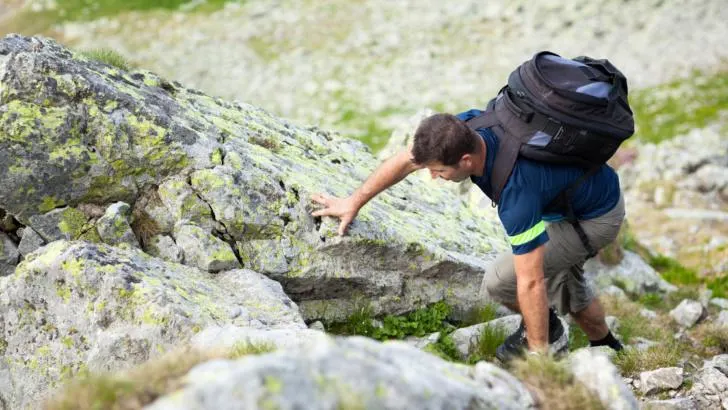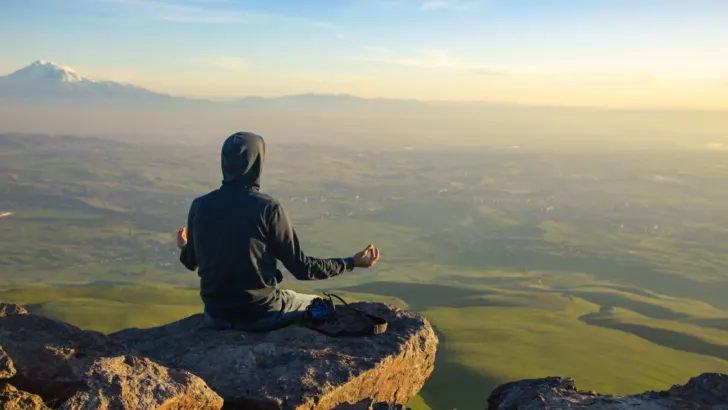Hiking is a great way to get outside, enjoy nature, and get some exercise. But how much hiking is too much? As someone who loves hiking, I’ve often wondered about the optimal amount of hiking to do in a day, week, or month. After doing some research and talking to experts, I’ve learned that the answer depends on a variety of factors.
Factors that affect how much hiking is too much include your fitness level, the intensity and duration of your hikes, and how much you’ve hiked in the past. It’s important to listen to your body and take breaks when you need them. Gradually increasing the distance and intensity of your hikes over time is also key to avoiding overtraining. Additionally, be sure to drink plenty of water and eat a healthy diet, and take rest days between hikes.

How Much Hiking is Too Much?
As an avid hiker, I often wonder how much hiking is too much. While it’s important to challenge ourselves and push our limits, we also need to be mindful of our physical and mental health. Here are some general guidelines to follow to help determine how much hiking is too much:
Physical Limitations
Our bodies have limitations, and it’s important to listen to them. Overdoing it can lead to injury or exhaustion. It’s essential to gradually increase the intensity and duration of our hikes to avoid overexertion. Here are some physical limitations to keep in mind:
- Age: As we age, our bodies become less resilient, and it takes longer to recover from physical activity.
- Fitness level: If you’re new to hiking, start with shorter, easier trails and gradually work your way up to more challenging hikes.
- Health conditions: Certain health conditions, such as asthma or heart disease, may limit your ability to hike.

Related posts:
Mental Health
Hiking can be a great way to reduce stress and improve mental health, but it’s important to recognize when it becomes too much. Here are some signs that you may be overdoing it:
- Feeling exhausted or burned out
- Loss of interest in hiking
- Difficulty sleeping
- Increased irritability or anxiety
Finding Balance
The key to determining how much hiking is too much is to find a balance between pushing ourselves and enjoying the journey. It’s important to listen to our bodies and be mindful of our physical and mental health. Gradually increasing the intensity and duration of our hikes, taking breaks when needed, and staying hydrated can help us find that balance. Remember, hiking should be enjoyable, not a chore.

Factors Affecting How Much Hiking is Too Much
Your Fitness Level
One of the most important factors that determine how much hiking is too much is your fitness level. If you are new to hiking or have been inactive for a long time, it’s important to start slowly and gradually increase the intensity and duration of your hikes. Pushing yourself too hard can lead to fatigue, injury, and burnout. It’s essential to listen to your body and adjust your pace and distance accordingly.
The Terrain
The terrain you are hiking on is another critical factor that affects how much hiking is too much. If you are hiking on flat terrain, you may be able to cover more distance than if you are hiking on steep and rugged terrain. Uphill hikes require more energy and can be more challenging, so it’s important to factor in the elevation gain and the steepness of the trail when planning your hike.

Your Load
The weight of your backpack or load is another factor that affects how much hiking is too much. Carrying a heavy load can be more challenging and can increase the risk of injury and fatigue. It’s essential to pack light and only bring the essentials. You can also consider using trekking poles to help distribute the load and reduce the impact on your joints.
Your Goals
Your hiking goals also play a role in determining how much hiking is too much. If you are training for a long-distance hike or planning to climb a mountain, you may need to push yourself harder and cover more distance. However, if you are hiking for leisure or relaxation, it’s important to take it easy and enjoy the scenery. It’s essential to set realistic goals and adjust your pace and distance accordingly.

In summary, several factors affect how much hiking is too much, including your fitness level, the terrain, your load, and your goals. It’s important to listen to your body, start slowly, and gradually increase the intensity and duration of your hikes. By taking these factors into account, you can enjoy hiking safely and without pushing yourself too hard.
Signs That You Are Hiking Too Much
As much as we love hiking, it’s important to know when we’re pushing ourselves too hard. Here are some signs that indicate you may be hiking too much.
Fatigue
If you’re feeling tired and worn out, it could be a sign that you’re hiking too much. Pushing yourself too hard can lead to exhaustion, which can cause a host of other problems. If you find yourself struggling to keep up with your usual pace, take a break and rest.
Dehydration
Dehydration is a common problem for hikers, especially during hot weather. If you’re not drinking enough water, you may experience symptoms such as dizziness, headaches, and dry mouth. To prevent dehydration, make sure you drink plenty of water before, during, and after your hike.

Heat Exhaustion
Heat exhaustion can occur when you’re hiking in hot weather and not taking enough breaks or drinking enough water. Symptoms include nausea, headache, dizziness, and fatigue. If you’re experiencing any of these symptoms, find a shaded spot and rest. Drink plenty of water and wait until you feel better before continuing your hike.
Altitude Sickness
Altitude sickness can occur when you’re hiking at high altitudes. Symptoms include headache, nausea, dizziness, and shortness of breath. If you’re hiking at high altitudes, make sure you take plenty of breaks and drink plenty of water. If you’re experiencing any symptoms of altitude sickness, descend to a lower altitude as soon as possible.
Remember, it’s important to listen to your body and take breaks when you need them. Hiking should be enjoyable, not painful. If you’re experiencing any of these symptoms, it’s a sign that you’re hiking too much. Take a break, rest, and drink plenty of water before continuing your hike.

The Specific Amount of Hiking That Is Considered Too Much for Different Fitness Levels
When it comes to hiking, it’s important to find a balance between pushing yourself and avoiding injury. The specific amount of hiking that is considered too much will vary depending on your fitness level. Here are some general guidelines to help you determine how much hiking is too much for you:
- Beginners: If you’re new to hiking or have a low level of fitness, it’s important to start slowly. Aim for shorter hikes of 1-2 miles with minimal elevation gain. As you build up your endurance, gradually increase the length and difficulty of your hikes. Avoid hiking for more than 2-3 hours at a time until you feel comfortable with longer durations.
- Intermediate Hikers: If you’re comfortable with hiking 3-5 miles on moderate terrain, you can start to increase the difficulty of your hikes. Aim for hikes with more elevation gain and longer durations. You can also start to incorporate backpacking trips to build up your endurance. Avoid hiking for more than 6-8 hours at a time until you feel comfortable with longer durations.
- Advanced Hikers: If you’re an experienced hiker with a high level of fitness, you can push yourself to hike longer distances and more difficult terrain. Aim for hikes with significant elevation gain and durations of 8-12 hours. You can also start to incorporate multi-day backpacking trips to build up your endurance. However, even advanced hikers should avoid hiking for more than 12 hours at a time to avoid overexertion and injury.

It’s important to listen to your body and avoid pushing yourself too hard. If you feel fatigued or experience pain or discomfort, it’s time to take a break or end your hike early. Remember to stay hydrated, wear appropriate footwear, and bring plenty of snacks and water with you on your hikes. By following these guidelines, you can safely enjoy the benefits of hiking without risking injury or overexertion.
The Ideal Intensity and Duration of Hikes for Avoiding Overtraining
When it comes to hiking, it’s important to find the right balance between intensity and duration to avoid overtraining. As an experienced hiker, I have found that hiking at a moderate intensity for a reasonable amount of time is the best way to maximize fitness gains while minimizing the risk of injury and burnout.
According to the search results I found, overexerting yourself to get fitter faster only increases your risk of injury and burnout. Doing too much high-intensity exercise, or any form of exercise, too often without proper recovery can also lead to metabolic issues, including overtraining syndrome and lactic acid buildup. Therefore, it’s important to find the right balance between intensity and duration to avoid overtraining.
Based on my personal experience and the search results, I recommend hiking at a moderate intensity for 60-90 minutes per session, 2-3 times per week. This duration and frequency provide enough stimulus for your body to adapt and improve while allowing for proper recovery between sessions.

It’s also important to consider the terrain and elevation gain of your hikes. If you’re hiking on steep terrain or at a high altitude, you may need to adjust your intensity and duration accordingly. For example, if you’re hiking on a steep trail, you may need to slow down your pace to maintain a moderate intensity.
In summary, hiking at a moderate intensity for 60-90 minutes, 2-3 times per week, is the ideal duration and frequency for avoiding overtraining. However, it’s important to listen to your body and adjust your intensity and duration based on the terrain and elevation gain of your hikes.
Tips for Recovering from Overtraining
As someone who loves hiking, I know how easy it can be to push yourself too hard. Overtraining can lead to fatigue, injury, and even illness. Here are some tips for recovering from overtraining:
- Rest: The most important thing you can do is rest. Take a break from hiking and allow your body to recover. This doesn’t mean you have to be completely sedentary, but avoid any activities that put stress on your body.
- Nutrition: Make sure you’re getting enough nutrients to support your recovery. Eat a balanced diet with plenty of protein, healthy fats, and complex carbohydrates. Consider taking supplements like omega-3 fatty acids, which can help reduce inflammation.
- Hydration: Staying hydrated is crucial for recovery. Drink plenty of water and electrolyte-rich beverages like coconut water or sports drinks.
- Massage: Massage can help reduce soreness and improve circulation. Consider getting a professional massage or using a foam roller or massage ball at home.
- Stretching: Stretching can help improve flexibility and reduce muscle tension. Focus on stretching the muscles you used during your hike, like your calves, quads, and hamstrings.
- Sleep: Getting enough sleep is essential for recovery. Aim for 7-9 hours of sleep per night and try to establish a consistent sleep schedule.

Remember, recovery is just as important as training. Don’t be afraid to take a break when you need it and listen to your body. With these tips, you can recover from overtraining and get back to hiking safely and comfortably.
Additional Tips for Avoiding Overtraining
When it comes to hiking, it’s important to listen to your body and avoid overtraining. Here are some additional tips to help you avoid overtraining and stay safe on the trails:
- Gradually Increase Intensity: If you’re new to hiking or haven’t hiked in a while, start with shorter, less intense hikes to build up your endurance. Gradually increase the intensity and duration of your hikes over time.
- Rest and Recovery: Rest is just as important as exercise. Make sure to take rest days between hikes to allow your body to recover. Incorporate stretching and foam rolling into your routine to help prevent injury and promote recovery.
- Proper Nutrition: Eating a balanced diet with plenty of protein, carbohydrates, and healthy fats is important for fueling your hikes and aiding in recovery. Make sure to eat before and after your hikes to keep your energy levels up and promote recovery.
- Hydration: Staying hydrated is essential for any physical activity, especially hiking. Make sure to bring plenty of water and electrolyte-rich drinks on your hikes, and drink regularly throughout your hike.
- Cross-Train: Incorporating other forms of exercise, such as strength training or yoga, can help prevent overuse injuries and improve your overall fitness.

By following these tips, you can avoid overtraining and stay safe on the trails. Remember to always listen to your body and adjust your hiking routine as needed.
Listen to Your Body and Take Breaks When You Need Them
As someone who loves hiking, I know how easy it is to get caught up in the thrill of the trail and push yourself to go further and harder. However, it’s important to listen to your body and take breaks when you need them.
One of the most important things you can do while hiking is to pay attention to how your body feels. If you start to feel tired, sore, or out of breath, it’s time to take a break. Pushing yourself too hard can lead to injury or exhaustion, which can ruin your hiking experience.
When you do take a break, make sure to elevate your feet and take some deep breaths to help your body recover. You can also use compression bandages to support any sore or injured areas and apply ice to reduce inflammation.

It’s also important to stay hydrated while hiking. Make sure to bring plenty of water and take regular sips throughout your hike. Dehydration can cause headaches, dizziness, and fatigue, which can make it difficult to continue hiking.
In summary, don’t be afraid to take breaks and listen to your body while hiking. It’s better to take it slow and enjoy the experience than to push yourself too hard and risk injury or exhaustion.
Gradually Increase the Distance and Intensity of Your Hikes Over Time
When it comes to hiking, it’s important to start slow and gradually increase both the distance and intensity of your hikes over time. This will help you build endurance and resilience without risking harm to your body.
I personally like to use the guidelines provided by Backpacker, which suggest increasing the length of your hikes gradually, resting one day every week, and mixing up your workouts. Variety not only helps you avoid a repetitive stress injury, but it also strengthens stabilizing muscles that we seldom think of until they’re screaming one day.
I also recommend setting realistic goals for yourself and tracking your progress. For example, you could start with a short, easy hike and gradually increase the distance or elevation gain each time you go out. You could also try adding weight to your backpack or increasing your speed to make the hike more challenging.

It’s important to listen to your body and not push yourself too hard too fast. If you experience pain or discomfort during a hike, it’s a sign that you need to slow down or take a break. Remember, hiking is supposed to be enjoyable, not painful or exhausting.
Overall, by gradually increasing the distance and intensity of your hikes over time, you can build the endurance and resilience needed for longer and more challenging hikes without risking harm to your body.
Be Sure to Drink Plenty of Water and Eat a Healthy Diet
As someone who enjoys hiking, it is important to keep in mind that staying hydrated and consuming a healthy diet is crucial. Hiking for extended periods of time can be strenuous, and it is essential to keep your body fueled with the right nutrients and fluids.
Water is the most important fluid to consume while hiking. The amount of water you need to drink will depend on the length and intensity of your hike, as well as the temperature and humidity of the environment. As a general rule of thumb, it is recommended to drink at least 2 liters of water per day, but this amount may increase if you are hiking in hot and dry conditions.
In addition to water, it is also important to consume other fluids and foods that can help replenish electrolytes and provide energy. Sports drinks, coconut water, and fruit juices can be great options for replenishing electrolytes lost through sweating. Snacks like nuts, dried fruits, and energy bars can provide a quick source of energy and nutrients.

When planning your meals for a hike, aim to consume a balanced and nutritious diet that includes a variety of foods. Carbohydrates can provide energy for your hike, so consider packing foods like whole-grain bread, pasta, and fruits. Protein is also important for muscle recovery and can be found in foods like nuts, seeds, and lean meats.
It is also important to avoid consuming too much caffeine or alcohol, as they can dehydrate the body and cause fatigue. Stick to water and other hydrating fluids to keep your body functioning at its best.
Overall, staying hydrated and consuming a healthy diet is essential for a successful and enjoyable hiking experience. Make sure to plan ahead and pack plenty of fluids and nutritious snacks to keep your body fueled and energized throughout your hike.
Take Rest Days Between Hikes
As someone who enjoys hiking, it can be tempting to push yourself to hike as often as possible. However, it’s important to remember that rest days are just as important as hiking days.
When planning a hiking schedule, I make sure to schedule rest days between hikes. This allows my body to recover and prevents overuse injuries. I typically aim for one or two rest days per week, depending on the intensity and duration of my hikes.
During rest days, I focus on activities that promote recovery, such as stretching, foam rolling, and gentle yoga. I also make sure to stay hydrated and eat nutritious foods to support my body’s recovery.

In addition to preventing injuries, taking rest days can also improve the quality of my hiking. When I’m well-rested, I have more energy and stamina to tackle challenging trails. I also find that taking rest days allows me to appreciate the beauty of nature more fully, as I’m not as focused on pushing myself to complete a hike.
Overall, I believe that taking rest days is essential for maintaining a healthy and enjoyable hiking routine. By prioritizing rest and recovery, I’m able to hike more safely and comfortably and enjoy the outdoors to the fullest.
Conclusion
In conclusion, determining how much hiking is too much can be a complex issue that depends on various factors. As I have discussed in this article, these factors include age, fitness level, terrain, weather, and overall health.
It is important to listen to your body and not push yourself beyond your limits. Overdoing it can lead to injuries, fatigue, and burnout, which can negatively impact your overall hiking experience.

To avoid overexertion, it is recommended that hikers gradually increase their mileage and take rest days as needed. Proper nutrition and hydration are also key to maintaining energy levels and preventing fatigue.
Ultimately, the amount of hiking that is too much will vary from person to person. It is important to find a balance that works for you and to always prioritize your safety and well-being.
Resources
- American Hiking Society: https://americanhiking.org/
- The American Heart Association: https://www.heart.org/
- Mayo Clinic: https://www.mayoclinic.org/
- Healthline: https://www.healthline.com/
- Verywell Fit: https://www.verywellfit.com/
Frequently Asked Questions
What is the recommended maximum distance to hike in a day?
The recommended maximum distance to hiking in a day varies depending on the individual’s fitness level, experience, and terrain. Generally, it is recommended to start with shorter distances and gradually increase mileage as fitness goals are met. A good rule of thumb is to hike no more than 10 miles per day for beginners and up to 20 miles per day for experienced hikers.
How many miles can an experienced hiker cover in a day?
An experienced hiker can cover anywhere from 15 to 30 miles per day, depending on the terrain and their fitness level. However, it’s important to note that pushing oneself too hard can lead to injury or exhaustion, so it’s crucial to listen to your body and adjust accordingly.
What factors should be considered when determining how much hiking is too much?
Several factors should be considered when determining how much hiking is too much, including the individual’s fitness level, experience, age, and terrain. It’s also essential to consider the weather conditions, elevation gain, and the weight of the backpack. It’s recommended to start with shorter distances and gradually increase mileage as fitness goals are met.
How does elevation gain impact how much hiking is too much?
Elevation gain can impact how much hiking is too much, as it requires more energy and can be more challenging than hiking on flat terrain. It’s recommended to start with shorter distances and gradually increase mileage as fitness goals are met. It’s also crucial to acclimate to higher elevations gradually, as altitude sickness can be a severe health risk.
What are the potential health risks of hiking too much?
Hiking too much can lead to several health risks, including dehydration, exhaustion, muscle strains, and injuries. It’s essential to listen to your body and adjust accordingly to avoid these health risks.
At what point does hiking become excessive and potentially harmful to the body?
Hiking becomes excessive and potentially harmful to the body when an individual pushes themselves beyond their limits and ignores the signs of exhaustion or injury. It’s crucial to listen to your body and adjust accordingly to avoid potential harm. It’s also recommended to consult with a healthcare professional before embarking on any strenuous hiking activities, especially if you have underlying health conditions.
